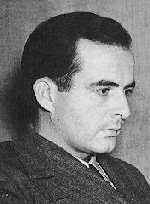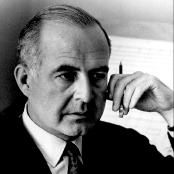Samuel Barber (1910 - 1981)
 American
composer Samuel Barber often confuses critics. He founded no school; he
stuck to no one style. As a public figure, he seemed aloof from the various
critical fights of American music: tonal vs. atonal, Stravinsky vs. Schoenberg,
and old-guard vs. modern. Almost all the other big names of American modernism
- Aaron Copland, Roy Harris, Walter Piston, David Diamond, Leonard Bernstein,
Virgil Thomson, Roger Sessions, and Milton Babbitt - allied themselves
with particular camps. Barber seemed just to write music, and, in so doing,
became controversial, someone to be attacked or defended.
American
composer Samuel Barber often confuses critics. He founded no school; he
stuck to no one style. As a public figure, he seemed aloof from the various
critical fights of American music: tonal vs. atonal, Stravinsky vs. Schoenberg,
and old-guard vs. modern. Almost all the other big names of American modernism
- Aaron Copland, Roy Harris, Walter Piston, David Diamond, Leonard Bernstein,
Virgil Thomson, Roger Sessions, and Milton Babbitt - allied themselves
with particular camps. Barber seemed just to write music, and, in so doing,
became controversial, someone to be attacked or defended.
Barber distinguished himself as a melodist. Almost everything
he wrote has at least one gorgeous tune or memorable theme. This alone
got him into trouble in certain circles as a stick-in-the-mud or even as
a panderer to the vulgar. However, his gift also genuinely puzzled people.
There is nothing in a Barber piece that instantly proclaims the composer,
as a Copland, Ralph Vaughan Williams, or Sergei Prokofiev work surely does.
His melodic emphasis led certain critics to label him "neo-Romantic," a
word that doesn't mean all that much. Almost nothing he wrote could have
been produced in the Romantic era. The harmonies are too complex and sometimes
extremely dissonant, the approach to form is as modern as Igor Stravinsky's,
and the orchestration is usually quite experimental. That his music sounds
full and rich simply means that the experiment succeeds.
 Although
no prodigy, Barber nevertheless made his mark early. Op. 1, Serenade
for string quartet (later orchestrated for strings), he wrote while attending
the Curtis Institute. Definitely a student work, it can fairly be called
"Romantic," in the tradition of Edvard Grieg's
Holberg Suite, Carl
Nielsen's Little Suite (also an op. 1), and Edward Elgar's Serenade
in e. However, by op. 5, Overture to the School for Scandal,
we have flown far beyond the nineteenth century. The orchestration and
opening bitonal harmonies may derive from Richard Strauss (although they
sound clearer), but the second, pastoral tune - as diatonic as Robert Schumann
- is something new. It seems to come from nowhere, and yet it sings in
a full-throated, natural way.
Although
no prodigy, Barber nevertheless made his mark early. Op. 1, Serenade
for string quartet (later orchestrated for strings), he wrote while attending
the Curtis Institute. Definitely a student work, it can fairly be called
"Romantic," in the tradition of Edvard Grieg's
Holberg Suite, Carl
Nielsen's Little Suite (also an op. 1), and Edward Elgar's Serenade
in e. However, by op. 5, Overture to the School for Scandal,
we have flown far beyond the nineteenth century. The orchestration and
opening bitonal harmonies may derive from Richard Strauss (although they
sound clearer), but the second, pastoral tune - as diatonic as Robert Schumann
- is something new. It seems to come from nowhere, and yet it sings in
a full-throated, natural way.
In his early work, Barber taps into this new lyricism in piece
after piece. Outstanding examples include Music for a Scene from Shelley,
Symphony
No. 1, First Essay for Orchestra, cello sonata, string quartet
(from which Barber orchestrated the Adagio for Strings, his best-known
piece), the choral classic Reincarnations, and the violin concerto.
The violin concerto (1939) is a transitional work: the first two
movements sing sweetly and intently; the last movement burns the barn down
with complex meters and new dissonances. From here, Barber moves definitely
into the modern period, to some extent influenced by Stravinsky, but absorbing
these influences into new idioms. The works of the 1940s (most clearly,
the Capricorn Concerto for flute, oboe, trumpet, and strings) lean
very strongly to neo- classicism. Yet none of them shows a consistent approach.
These works include Symphony No. 2, Second Essay for Orchestra,
the cello concerto, the ballet Medea, Souvenirs (a suite
of nineteenth-century ballroom dances), the piano sonata, Commando March
for band, and the glorious Knoxville: Summer of 1915 for soprano
and orchestra. Despite the broadening of his musical language, Barber never
loses his lyrical gift. Each of these works is stuffed with themes that
stick in the memory.
Postwar, Barber continued going his own way. Some major works
of the period are the Toccata Festiva for organ and orchestra, Summer
Music for woodwind quintet, the "Wondrous Love" variations for organ,
Hermit
Songs, the choral Prayers of Kierkegaard, a magnificent piano
concerto, Andromache's Farewell for soprano and orchestra, and three
operas: Vanessa, A Hand of Bridge, and Antony and Cleopatra,
the first two with libretti by the composer Gian Carlo Menotti, the last
using much of the Shakespeare play.
Antony and Cleopatra (1966; revised 1974) cut Barber's
composing activities short. He never had written all that much, although
what he did publish usually entered standard repertoire. Further, he published
much less than he wrote. For example, of more than 100 songs, he published
only 38. Antony and Cleopatra, a high-profile commission from the
Metropolitan Opera to inaugurate its new house at Lincoln Center, flopped
miserably, due mainly to a bloated, incompetent production from the director
and original librettist Zeffirelli. The production occasioned a fury of
critical attack, essentially condemning Barber as irrelevant to the music
of the time, whatever that may mean. Barber never recovered his stride
after this. He continued to compose, but very sporadically, and to revise
Antony.
Works from this period include Fadograph of a Yestern Scene (1971),
Third Essay for Orchestra (1978), and Canzonetta for oboe
and strings (1978).
The later pieces were not performed much during his lifetime.
The major organizations which had competed to commission him lost interest.
However, his music, never completely out of public regard, has begun to
come back. Almost all his output has made it to CD in various performances.
The critical wars during his life have to a large extent ceased to matter.
The music continues to matter.
 Although
no prodigy, Barber nevertheless made his mark early. Op. 1, Serenade
for string quartet (later orchestrated for strings), he wrote while attending
the Curtis Institute. Definitely a student work, it can fairly be called
"Romantic," in the tradition of Edvard Grieg's
Holberg Suite, Carl
Nielsen's Little Suite (also an op. 1), and Edward Elgar's Serenade
in e. However, by op. 5, Overture to the School for Scandal,
we have flown far beyond the nineteenth century. The orchestration and
opening bitonal harmonies may derive from Richard Strauss (although they
sound clearer), but the second, pastoral tune - as diatonic as Robert Schumann
- is something new. It seems to come from nowhere, and yet it sings in
a full-throated, natural way.
Although
no prodigy, Barber nevertheless made his mark early. Op. 1, Serenade
for string quartet (later orchestrated for strings), he wrote while attending
the Curtis Institute. Definitely a student work, it can fairly be called
"Romantic," in the tradition of Edvard Grieg's
Holberg Suite, Carl
Nielsen's Little Suite (also an op. 1), and Edward Elgar's Serenade
in e. However, by op. 5, Overture to the School for Scandal,
we have flown far beyond the nineteenth century. The orchestration and
opening bitonal harmonies may derive from Richard Strauss (although they
sound clearer), but the second, pastoral tune - as diatonic as Robert Schumann
- is something new. It seems to come from nowhere, and yet it sings in
a full-throated, natural way.
 American
composer Samuel Barber often confuses critics. He founded no school; he
stuck to no one style. As a public figure, he seemed aloof from the various
critical fights of American music: tonal vs. atonal, Stravinsky vs. Schoenberg,
and old-guard vs. modern. Almost all the other big names of American modernism
- Aaron Copland, Roy Harris, Walter Piston, David Diamond, Leonard Bernstein,
Virgil Thomson, Roger Sessions, and Milton Babbitt - allied themselves
with particular camps. Barber seemed just to write music, and, in so doing,
became controversial, someone to be attacked or defended.
American
composer Samuel Barber often confuses critics. He founded no school; he
stuck to no one style. As a public figure, he seemed aloof from the various
critical fights of American music: tonal vs. atonal, Stravinsky vs. Schoenberg,
and old-guard vs. modern. Almost all the other big names of American modernism
- Aaron Copland, Roy Harris, Walter Piston, David Diamond, Leonard Bernstein,
Virgil Thomson, Roger Sessions, and Milton Babbitt - allied themselves
with particular camps. Barber seemed just to write music, and, in so doing,
became controversial, someone to be attacked or defended.